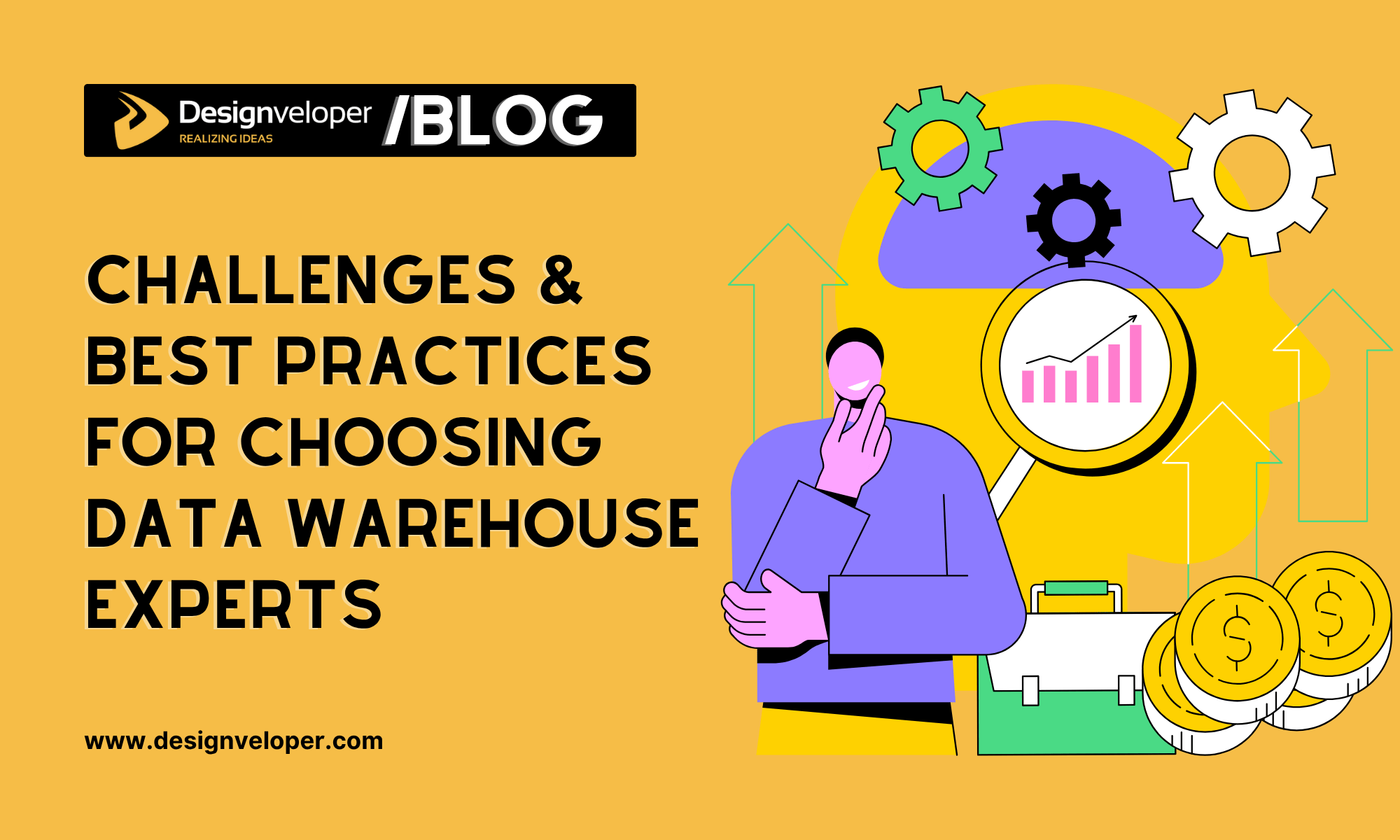Challenges & Best Practices for Choosing Data Warehouse Experts: How To Ask Questions To Verify Their Qualifications

As the amount of data continues to grow, companies increasingly need to work with cloud services, storage facilities, and even data lakes. However, working with them is only simple at first glance. One of the typical mistakes is turning a resource into a dump of raw and uncoordinated data. As a result, the company pays for the service but does not get the maximum return. It does not receive the benefits that it could if it hired strong specialists: quick access to consistent data, transparent analytics, and reduced support costs. Most importantly, it loses the ability to make informed business decisions based on verified information.
However, finding true experts is very difficult. This is because the field is relatively young. The market is growing rapidly but remains immature: many specialists may have experience working with individual tools, but have never worked with full-fledged architecture, integration, or business logic. The experts at Cobit Solutions share with you how to distinguish superficial competence from real experience, and what criteria help you choose a specialist who can bring real business value.

5 Common Mistakes Customers Make When Choosing Experts
When a company enters the stage of searching for a data storage specialist, it often perceives this process as a technical procurement of services. In reality, a mistake at the outset can determine the fate of the entire project. There are several typical situations that occur most often.
- The first is the absence of a clear technical or business request. When the task is formulated vaguely, the expert begins to act according to their own understanding, which sometimes leads to a gap between management expectations and the result.
- The second is the attempt to find a ‘universal specialist.’ In reality, roles are divided: architect, engineer, analyst, DevOps. Expecting one person to cover all areas with high quality means risking both quality and deadlines.
- The third is ignoring the context. Cloud solutions require different architecture and competencies than on-premises environments; in addition, different industries have their own regulatory requirements for data. Failure to understand the scale of the system or future growth leads to decisions that quickly become irrelevant.
- The fourth is focusing solely on CVs and certificates. Formal qualifications do not guarantee successful projects. It is much more important to analyse real cases: what specific tasks the expert has solved, what volumes of data they have worked with, and how they have ensured the continuity of business processes.
- And finally, the fifth situation is the lack of an internal coordinator on the business side. Even the strongest external expert needs the participation of a company representative who can explain the context, gather requirements from different departments, and ensure consistency of actions. When there is no such intermediary, a gap arises between the technical solution and business reality.
Practical Tips For Choosing An Expert

- Contact experts with a clear request. This will help you avoid misunderstandings and determine at the outset whether the expert is proficient in a particular technology.
- Check their experience. Look for experts who have experience working with specific data storage platforms, such as Snowflake, Google BigQuery, or Amazon Redshift.
- Understanding business needs. An effective expert should understand your business goals and be able to tailor solutions to your needs.
- Technical skills. Knowledge of programming languages such as SQL and Python, as well as experience with ETL/ELT tools, are important.
- Communication skills. An expert should be able to communicate effectively with various stakeholders and explain technical aspects in accessible language.
These solutions seem obvious. However, to get truly high-quality data warehouse development services, you need to know what can happen if you work with inexperienced teams.
10 Critical Issues In The Work Of Technical Teams
When a company decides to implement a data warehouse on its own or wants to hire external specialists who offer the cheapest services, it often looks like a cost-saving measure. However, in practice, such a strategy regularly leads to systemic errors that reduce the effectiveness of the project or make it unsustainable in the long term.
1. Lack of agreed business goals and strategy.
Teams start implementation from a technical perspective without a clear understanding of which business processes the repository should support. As a result, the architecture does not meet real needs, and the data is not adapted to KPIs, reporting, or decision-making.
2. Overloading the repository with raw data.
Instead of building transformation, validation, and normalization logic, teams often simply “dump everything” into the repository. This creates chaos: duplicates, inconsistent formats, lack of context. The repository becomes an archive rather than an analytics tool.
3. Ignoring data quality.

Without clear rules for verifying, cleaning, and reconciling data, problems arise with trust in reports. Businesses cannot rely on analytics if the data contains errors, missing values, or conflicting metrics.
4. Non-optimized models and queries.
Teams without experience in building scalable models often create structures that cannot handle the load. Poorly designed table and query structures lead to slow system performance, resource overload, and difficulties in scaling and maintenance.
5. Lack of access control and security policies.
If the team does not implement a clear role-based access model, there is a risk that confidential data may fall into the hands of unauthorized persons. Without proper logging and restrictions, it is difficult to track who interacts with the data and when, which complicates auditing and control. This situation also violates regulatory requirements, such as GDPR, and can lead to legal consequences. In addition, the lack of structured access creates internal chaos: employees have access to unnecessary information, while critical areas remain uncontrolled.
6. Architecture is built without taking scalability and change into account.
Sometimes teams build storage “for current needs” without allowing for growth in volume, new data sources, or changes in the business model. This leads to the need to completely rebuild the storage in a year or two.
7. Uncertainty in data management rules.
Specialists without sufficient experience may not know how to establish rules for data ownership, versioning, updating, and archiving. Or they may simply forget about this necessity. Who owns each type of data? Who has the right to change, view, or delete data? How is data versioned, and who controls its relevance? What rules apply to storage, archiving, security, and auditing? The lack of a unified data management logic complicates integration, auditing, support, and knowledge transfer.
8. Lack of monitoring of ETL processes and costs.
If the team does not set up monitoring of ETL processes, they run uncontrolled: without execution logs, error notifications, or time tracking. In the event of a failure, it will be difficult to understand where the problem occurred and what data was lost. In addition, without cost control, ETL processes can consume excessive resources, leading to unexpected costs in the cloud environment.
9. Underestimating the team’s training and adaptation needs.
Hired specialists may not have experience working with modern platforms (e.g., Snowflake, BigQuery, Azure Synapse) and may not undergo training. This leads to inefficient use of tools, configuration errors, and loss of potential benefits.
10. Excessive complexity of models.
If the technical team creates overly complex, fragmented models—without clear logic, consistent levels, and a comprehensible structure—this leads to a number of issues. The business cannot interpret the information, analysts cannot work effectively with the data, and new team members cannot adapt quickly. This complicates analytics, integration, and system support.
Checklist For Avoiding Common Problems
Now let’s look at how to avoid the problems mentioned above and what exactly to ask specialists so that you don’t pay for ineffective solutions.
1. Demand a business-oriented approach.
To avoid problems with the alignment of business goals and strategies, choose specialists who ask questions about your business processes rather than immediately presenting their tools. Clarify how they adapt the architecture to KPIs, reporting, and decision-making.
2. Check their experience with full-fledged architecture.
To avoid overloading your storage with raw data, ask how the candidate structures pipelines: are there stages of cleaning, normalization, and reconciliation? Ask for examples of implemented models.
3. Evaluate the approach to data quality.
To avoid issues with ignoring duplicates, omissions, and inconsistent formats, make sure that the specialist uses validation rules, data profiling, and automatic cleaning. Ask how they ensure trust in analytics.
4. Ask for examples of optimization.
To avoid slow performance and resource overload, ask how the candidate optimizes queries, structures, and calculations. Do they use indexes, partitioning, caching, and clustering?
5. Check security and access knowledge.
Lack of access control and regulatory violations are a big problem. Therefore, clarify how the specialist implements the role model, logging, and access restrictions. Does he take into account the requirements of GDPR, ISO, SOC2?
6. Assess scalability.
Architecture built solely for current tasks quickly becomes obsolete. Therefore, clarify whether the specialist takes into account the growth of data volumes, the emergence of new sources, and changes in the business model. It is important that the solution is modular and flexible—able to adapt without complete restructuring.
7. Demand clear data management logic.
Uncertainty in data management rules leads to confusion: it is unclear who is responsible for updates, storage, or versioning. Clarify whether the specialist establishes clear rules for ownership, archiving, and change control. It is significant that they have experience working with data catalogs or metadata management systems — this is the basis for transparent integration and support.
8. Check the monitoring approach.
ETL processes without systematic monitoring do not detect failures, data loss, or resource overruns. And that’s a big problem. Therefore, clarify how the specialist implements logging, error notifications, execution time control, and cost accounting. It is critical that the system has automatic monitoring — this is the basis for stability and transparency in a cloud environment.
9. Assess the ability to train and adapt the team.
If the team does not understand the tools, it will not be able to maintain decisions, adapt them to changes, or scale them. Therefore, it is important that the specialist be able to explain their actions, document processes, and train others. This ensures that the team can work independently, without constant external support.
10. Demand simplicity and logic.
Overly complex models are difficult to maintain, scale, and integrate into business processes. Therefore, clarify whether the specialist is building solutions with transparent logic — ones that are easy to adapt and understand for business users. Ask for examples not only of technical implementation, but also explanations that are accessible to a non-technical audience.
Conclusions And Recommendations
There are no universal solutions when working with data — and this applies not only to technology, but also to people. Roles need to be divided: analyst, architect, engineer, consultant — everyone has their own area of responsibility, and the selection criteria must correspond to the specific task you want to solve. If this is not done, it is easy to end up with a “generalist” who is unable to meet a specific need.
Therefore, it is worth creating an internal framework — a set of simple but clear tools: checklists, question templates, competency matrices. This is the best way to check whether a candidate really understands your context, knows how to work with your constraints, and is capable of delivering results that have business value.

















































